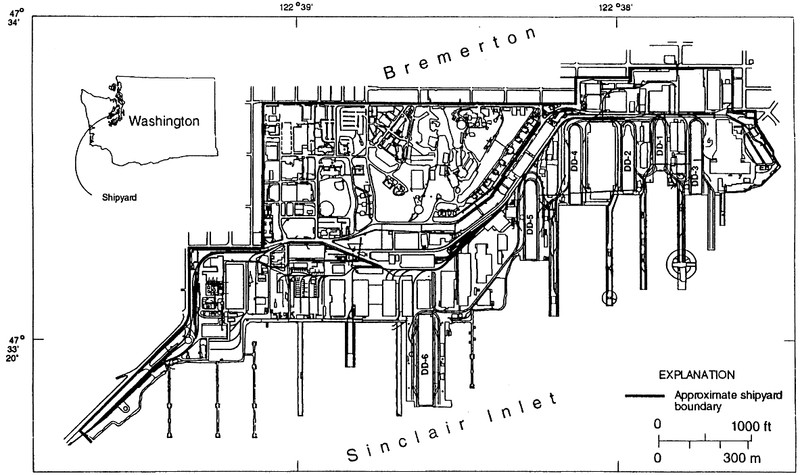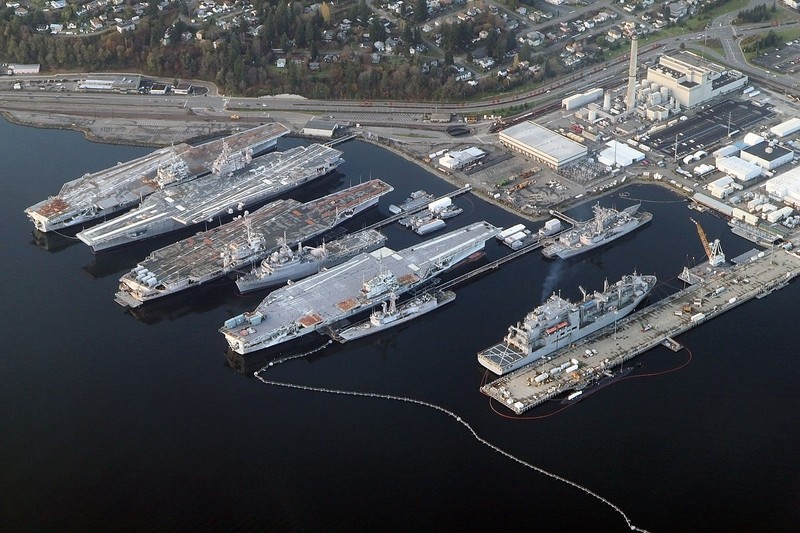Puget Sound Naval Shipyard and Intermediate Maintenance Facility
Introduction
Text-to-speech Audio
Originally established in 1891 as a Naval Station, Puget Sound Naval Shipyard has built and serviced the nation’s naval ships through two World Wars and modern conflicts. The shipyard has seen a host of technological changes, as well as fluctuations in military spending and policy. In 1992, the shipyard was placed on the National Register of Historic Places. Today, the Puget Sound Naval Shipyard is the largest naval shipyard in the Pacific Northwest and one of Washington's largest industrial complexes. Owing to its role in World War II, the shipyard is listed on the National Register of Historic Places. During that conflict crews at the shipyard repaired 26 battleships, 18 aircraft carriers, 13 cruisers, and 79 destroyers.
Images
Map layout of the shipyard

4 decommissioned aircraft carriers docked at the shipyard

Backstory and Context
Text-to-speech Audio
On Sept. 16, 1891, the Navy finalized the purchase of the original 145 acres of land that became Naval Station Puget Sound. Lieutenant Wyckoff served as the station’s first commandant and oversaw the official groundbreaking in 1892. Construction of the station's dry-dock where ships were constructed prior to their launch took than three years and was completed on April 22, 1896. The first naval vessel in the dry-dock was the coastal defense monitor, U.S.S. Monterey which had been constructed in San Francisco. The first battleship to be docked at Puget Sound was the U.S.S. Oregon on April 11, 1897.
During America's involvement in World War I, Navy Yard Puget Sound built twenty-five submarine chasers, six submarines, two minesweepers, seven seagoing tugboats, and two ammunition ships as well as 1,700 small boats. After the war, the U.S. fleet arrived in the Pacific Ocean and many of the ships that were sent to war were scheduled for repair and rearmament at the PSNS. Only two ships were built in the 1920s; the U.S.S. Medusa and the U.S.S. Holland. A third ship, the U.S.S. Louisville, began construction in July 1928 and was launched in September 1930.
During World War II the PSNS was turned from manufacturing and building ships to repairing the damaged ships of the U.S. Pacific Fleet. After the Japanese attack on Pearl Harbor, five of the six surviving battleships were sent to the Bremerton shipyard for modifications and repair: U.S.S. Tennessee, U.S.S. Maryland, U.S.S. Nevada, U.S.S. California, and U.S.S. West Virginia. During the war, Navy Yard Puget Sound repaired 26 battleships (some more than once), 18 aircraft carriers, 13 cruisers, and 79 destroyers. After the war, the PSNS was transformed from ship repair to ship deactivation of some ships in the Pacific Fleet. While transforming ships to deactivation other programs involved modernizing aircraft carriers to use newer aircraft.
Between 1948 and 1962, Puget Sound Naval Shipyard updated nine aircraft carriers to reflect the needs of the modern Navy: the U.S.S. Essex, U.S.S. Kearsarge, U.S.S. Yorktown, U.S.S. Hancock, U.S.S. Lexington, U.S.S. Shangri-la, U.S.S. Franklin D. Roosevelt, and the U.S.S. Coral Sea. Along with the repair and expansion of these aircraft carriers, this shipyard was also the site of the construction of numerous submarines including the U.S.S. Capitaine followed by the U.S.S. Bugara, U.S.S. Sculpin, and the U.S.S. John Adams.
During America's involvement in World War I, Navy Yard Puget Sound built twenty-five submarine chasers, six submarines, two minesweepers, seven seagoing tugboats, and two ammunition ships as well as 1,700 small boats. After the war, the U.S. fleet arrived in the Pacific Ocean and many of the ships that were sent to war were scheduled for repair and rearmament at the PSNS. Only two ships were built in the 1920s; the U.S.S. Medusa and the U.S.S. Holland. A third ship, the U.S.S. Louisville, began construction in July 1928 and was launched in September 1930.
During World War II the PSNS was turned from manufacturing and building ships to repairing the damaged ships of the U.S. Pacific Fleet. After the Japanese attack on Pearl Harbor, five of the six surviving battleships were sent to the Bremerton shipyard for modifications and repair: U.S.S. Tennessee, U.S.S. Maryland, U.S.S. Nevada, U.S.S. California, and U.S.S. West Virginia. During the war, Navy Yard Puget Sound repaired 26 battleships (some more than once), 18 aircraft carriers, 13 cruisers, and 79 destroyers. After the war, the PSNS was transformed from ship repair to ship deactivation of some ships in the Pacific Fleet. While transforming ships to deactivation other programs involved modernizing aircraft carriers to use newer aircraft.
Between 1948 and 1962, Puget Sound Naval Shipyard updated nine aircraft carriers to reflect the needs of the modern Navy: the U.S.S. Essex, U.S.S. Kearsarge, U.S.S. Yorktown, U.S.S. Hancock, U.S.S. Lexington, U.S.S. Shangri-la, U.S.S. Franklin D. Roosevelt, and the U.S.S. Coral Sea. Along with the repair and expansion of these aircraft carriers, this shipyard was also the site of the construction of numerous submarines including the U.S.S. Capitaine followed by the U.S.S. Bugara, U.S.S. Sculpin, and the U.S.S. John Adams.
Sources
McClary, Daryl C.. Puget Sound Naval Shipyard. November 04, 2004. Accessed May 04, 2018. http://www.historylink.org/File/5579.
Puget Sound Naval Shipyard and Intermediate Maintenance Facility History. Naval Sea Systems Command. Accessed May 04, 2018. http://www.navsea.navy.mil/Home/Shipyards/PSNS-IMF/History/.
Puget Sound Naval Shipyard and Intermediate Maintenance Facility History. Naval Sea Systems Command. Accessed May 04, 2018. http://www.navsea.navy.mil/Home/Shipyards/PSNS-IMF/History/.
